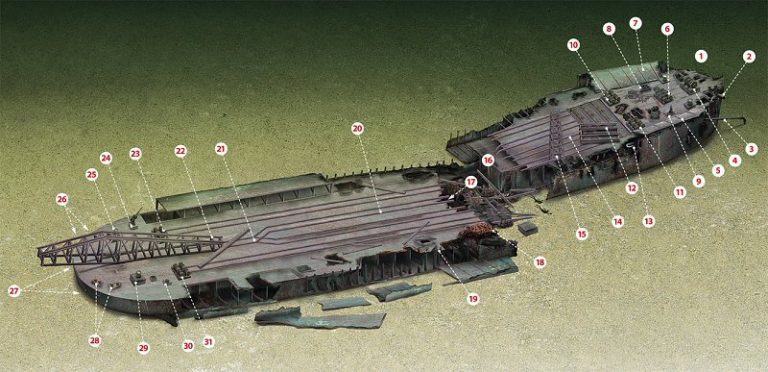How often do you get the chance to dive a train ferry that originated in WW1 but which had to wait until WW2 to see military service? Cross the Channel to Dieppe to do just that with JOHN LIDDIARD – illustration by MAX ELLIS
ONE OF THE THINGS I ENJOY MOST about wreck-diving is that every now and then I get to dive a wreck that is completely different to anything I have dived before.
One such is HMS Daffodil, a train ferry originally built as TF3, one of three such ships built to ship wagons of supplies across the Channel in World War One.
None were completed until after the Armistice, but all saw some commercial service between the wars, and then returned to military service in WW2.
TF3 was renamed HMS Daffodil. Towards the end of WW2 she sank after striking a mine, on the way home from shipping supplies into Dieppe.
Although on a pretty level seabed, the highest point of the wreck is a surviving section of shelter deck just back from the bow. It’s the spot where the freediving section of Rouen GCOB Plongée like to tie their buoyline, but for convenience we will begin our tour at a depth of about 15m, right at the tip of the bow (1).
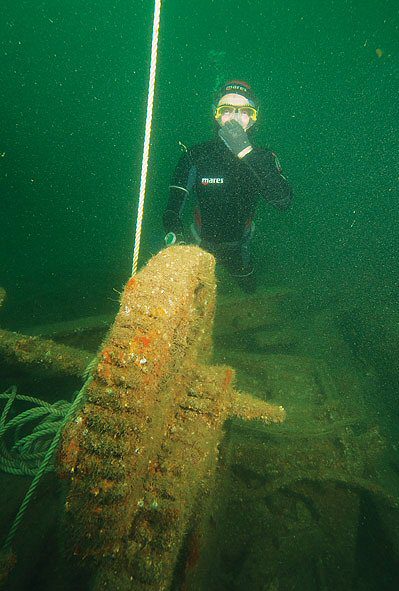
Here the shelter deck once extended over the main deck and bow fittings, but has now decayed to leave exposed anchor hawse-pipes (2) cut between the main deck and the hull. Below the starboard side, an arm (3) extending down the side of the hull to the seabed forward of the bow would have once connected to a similar, but now missing, arm from the other side of the hull. Its purpose was to tow minesweeping cables and paravanes from the bow.
Back on the main deck, a big anchor-winch (4) sits in the middle of the bow.
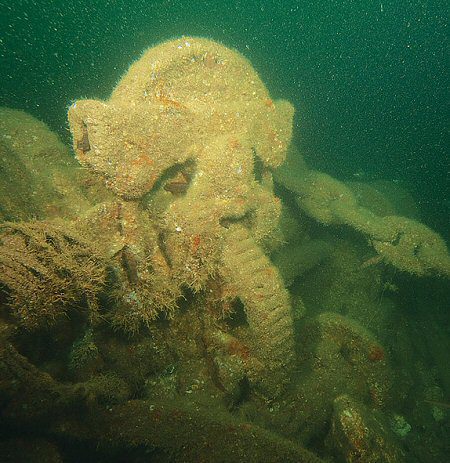
Our route aft now zigzags across the deck a few times. On the starboard side, the hull rises to the remains of the shelter deck (5), which then tips inwards.
From here, across the main deck are a pair of big capstans with a winch between them (6). These would have been used to haul mooring cables tight, to keep the ship stable against the loading pier so that railway wagons could be rolled on board at the stern without derailing.
On the port side, the shelter deck (7) is similarly tipped inward.
Now heading aft along the inward edge of the shelter deck, an anti-aircraft gun-mount (8) has fallen on its side amid scattered ammunition. This was one of four gun positions, essentially mounted one in each corner.
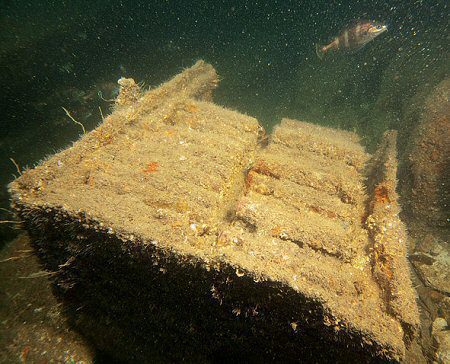
Cross the deck again, and an intact and upright mount (9) is located in the equivalent position on the starboard side.
Between the guns, a winch is located with its axis along the deck, so as to operate across the deck. Behind the guns, larger winches (10, 11) are arranged to operate along the deck.
These winches and some others we will see later were used to shunt railway wagons about the tracks on the deck, so that the ferry could handle wagons of supplies without needing to have locomotives on board.
Behind the winches are two short sections of track mounted above other track so that they could be slid from side to side (12). These were originally in line with the rails further aft, but are now rotated out of alignment.
This traversing cradle was used to shift wagons between sets of rails along the deck, pulled from side to side by the winch that operated across the deck that we passed earlier, located between the anti-aircraft gun-mounts.
As TF3, HMS Daffodil was originally built with points to shift wagons between the tracks. Additional track and the traversing cradle were subsequently fitted, both to speed loading and unloading and to add capacity.
Straying from the diver’s train-set for a while, tucked in beneath the shelter deck on the starboard side is a bath-tub (13).
The main deck continues with four sets of railway track leading aft (14). These are soon crossed by a latticed framework (15) that has fallen to the deck.
The location is roughly below where the wheelhouse would have spanned high above the main deck, so perhaps it was part of the supporting structure.
The hull then breaks (16), providing a view inside what are essentially big flat buoyancy tanks with a deck on top. Crossing some debris on the seabed, the intact part of the wreck soon resumes.
Contained within the hull are four boilers, two to each side (17). These are the usual cylindrical Scotch-type boilers, but pushed out against either side, so the flues could be routed to the side of the main deck, somewhat as they would be on an aircraft-carrier.
Or perhaps that should be the other way round; perhaps aircraft-carriers have the flues routed as they were on train ferries, because train ferries were invented first.
Back on deck, above the starboard boiler is a pile of chain (18), used to secure wagons while the ship was at sea. The sides of the hull and small areas of deck have decayed, particularly along this side, with the starboard engine just visible well back inside (19).
The side of the deck and the seabed off to the starboard side is strewn with boulders – not shown in the illustration, to keep the wreck clear. These were dumped here when the port of Dieppe was being extended, and have nothing to do with HMS Daffodil.
On the main deck, the four sets of track (20) continue aft until the centre sets merge at a set of points (21) to direct a single track onto the loading ramp (22). This ramp was another modification to the cargo-handling.
Originally, TF3 was fitted with two tracks all the way to the stern, to mate with a loading ramp from the shore. This would have restricted loading to ports fitted with such a ramp system, so HMS Daffodil was refitted with the single long ramp that could work with any port, as long as there was a railway line.
The ramp was completely removed for D-Day, so that landing craft could be rolled off the stern.
To the port side of the loading ramp, another winch (23) is lined up with the outer track, so it could have been used for wagon-handling, but also for raising and lowering the ramp. Behind this is another anti-aircraft gun (24), this time intact and pointing skyward.
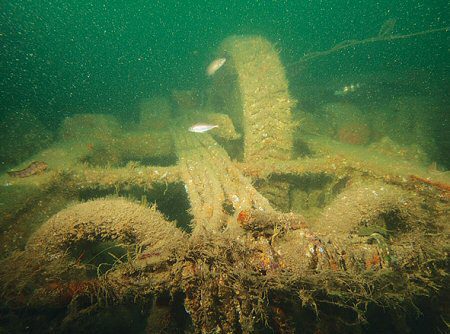
I mentioned the need for the stern of the ship to be held absolutely steady against the loading pier when rolling wagons on and off, so next we have another big capstan (25), followed by pairs of bollards along the edge of the deck (26).
HMS Daffodil has two propellers and two rudders, tucked well under the stern and either side of the loading ramp. The port propeller (27) is more accessible in a slight scour beneath the stern, to give a maximum depth of 24m on a high-water slack.
Back above deck, the starboard quarter is a mirror image of the port, with pairs of bollards (28), a big capstan (29), an anti-aircraft gun-mount (30) and a winch for shunting wagons (31). Here the anti-aircraft gun has broken from the mount, and there is more ammunition scattered about the base.
Which brings us to the end of our Wreck Tour. With the main deck at 19m, a dive time of getting on for an hour is possible with minimal decompression. With a twin-set and nitrox, or a rebreather, there is enough unusual wreckage to keep a dive interesting for considerably longer than that.
ODDBALL CONVERSION
HMS Daffodil, train ferry. BUILT 1914, SUNK 1945
THEY WERE THE WEIRDEST-LOOKING CRAFT of World War One – train ferries planned as ships to carry trains packed with men and other warlike supplies across the Channel, writes Kendall McDonald.
They operated from Richborough Military Port in Kent to Dunkirk. The three of them were laid up in 1922.
Near the start of WW2, three ships were requisitioned by the Royal Navy and known as Train Ferry No 1, No 2 and No 3. In 1940, TF1 and TF3 were renamed HMS Princess Iris and HMS Daffodil respectively, and a year later both ships were converted into landing-craft carriers. Their twin funnels trunked into one made them look even more warlike.
These ferries became part of Commando Combined Ops in Scotland, where the soldiers were introduced to the unusual concept. Up to 13 landing-craft packed with men could be hauled up to the covered train-deck of the carrier on trolleys, using a complicated switching system.
Launching the trolleys one by one and watching them race down the track was exciting for onlookers, as each one would throw up a great wall of water. This happened when King George VI, Winston Churchill and Lord Louis Mountbatten were observers.
The men on the craft, understandably, were less happy, and this violent method of launching was soon abandoned.
During the Normandy landings, craft from both Daffodil and Princess Iris rolled less forcibly off the stern-chutes to land troops on the beaches.
HMS Daffodil might have been a rust-bucket by now but she performed well on D-Day. She eventually struck a mine just north of Dieppe at 11pm on 17 March, 1945, and she and nine of her small crew were lost when she finally sank at 5am.
Only Princess Iris survived the war. She became TF1 again, then, as a civilian in 1946, was renamed Essex Ferry, carrying out three return trips a week.
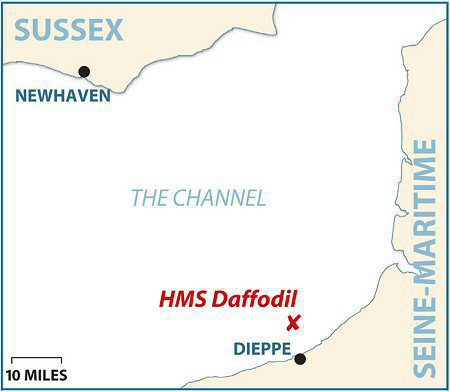
TOUR GUIDE
GETTING THERE: LD Lines Transmanche Ferries has twice-daily crossings from Newhaven to Dieppe. Five-day return fares for car and two passengers cost from £39. www.ldlines.com, 0844 576 8836.
HOW TO FIND IT: The GPS co-ordinates are 50 02.514N, 001 04.240E (degrees, minutes and decimals). The wreck lies to the east of an east cardinal buoy marked “Daffodil”, with the bow pointing to the south-east.
TIDES: On neap tides, slack water begins approximately 1 hour before and 5 hours after high-water Dover. Bear in mind that French clocks are an hour ahead of the UK.
DIVING & AIR: John Liddiard was a guest of French club visit GCOB Plongée. Alternatively, UK boats operating from Eastbourne, Brighton and Littlehampton have conducted multi-day cross-Channel trips, either taking divers with them or meeting them in Dieppe.
ACCOMMODATION: Office de Tourisme Dieppe Maritime.
LAUNCHING Slips are available in Dieppe, but first make sure that your boat and boat-handlers are fully licensed with the French authorities.
QUALIFICATIONS: At low-water slack, most of the wreck is accessible to PADI Open Water or BSAC Ocean Divers.
FURTHER INFORMATION: Admiralty Chart 2451, Newhaven to Dover. Admiralty Chart 2147, Approaches to Dieppe.
PROS: A unique wreck with train-set and guns.
CONS: French diving regulations are much more stringent than those at home.
DEPTH: 20-35m
Thanks to Alan Waite, Jean-Luc Lemaire, Denis, Dominique, Raymond and many members of Rouen GCOB Plongée.
Appeared in DIVER September 2011
